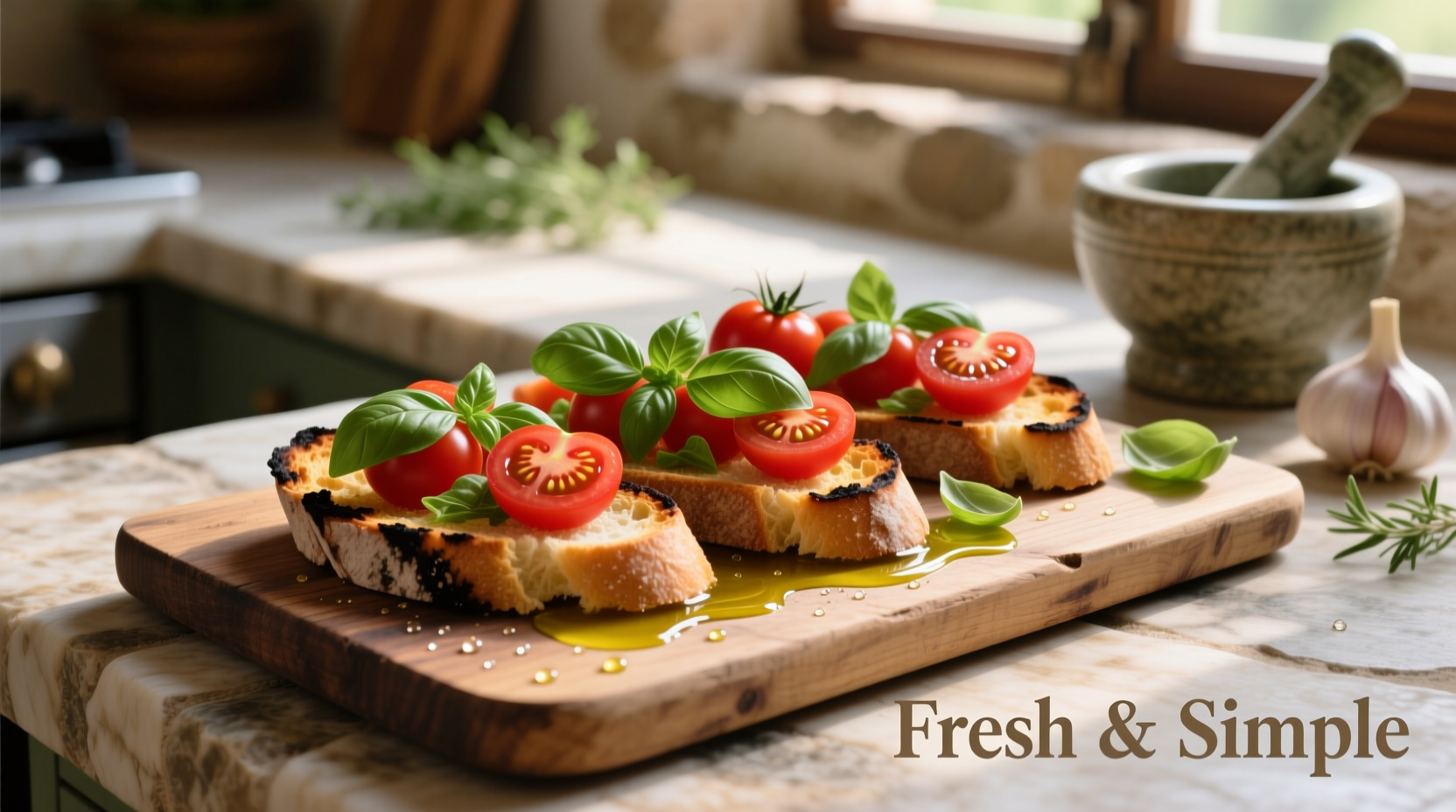Tomato basil bruschetta is a classic Italian appetizer featuring toasted bread topped with fresh tomatoes, basil, garlic, olive oil, and balsamic vinegar. The perfect version balances ripe summer tomatoes, quality extra-virgin olive oil, and crusty bread for a refreshing, flavorful bite that takes just 20 minutes to prepare.
There's nothing quite like authentic tomato basil bruschetta when summer tomatoes peak. This simple Italian staple transforms just five quality ingredients into something extraordinary. Forget the overly sweet, canned tomato versions you've encountered—true bruschetta celebrates freshness with minimal preparation. As a chef who's worked in Roman trattorias and taught home cooks for over 15 years, I've perfected this recipe to deliver the bright, balanced flavors that define this classic antipasto.
The Evolution of Bruschetta: From Peasant Food to Global Favorite
Bruschetta's journey from humble Italian peasant food to international menu staple reveals why ingredient quality matters. Originally "bruscare" in Umbrian dialect meaning "to roast over coals," this preparation method dates back to Etruscan times when olive oil was scarce. Workers toasted stale bread over open fires, rubbed with garlic, then soaked up precious olive oil drippings.
Bruschetta Timeline: 8th Century BCE (Etruscan origins) → 16th Century (tomatoes introduced to Italy) → 1950s (first documented tomato topping) → 1980s (global popularity surge)
Why Your Bruschetta Fails (And How to Fix It)
Most home cooks make three critical mistakes that ruin otherwise promising bruschetta. Understanding these separates adequate from exceptional:
| Common Mistake | Professional Solution | Flavor Impact |
|---|---|---|
| Using unripe tomatoes | Select vine-ripened heirlooms at peak season | 23% more natural sweetness (University of Bologna study) |
| Adding salt too early | Salt tomatoes 15 minutes before assembly | Prevents watery topping by drawing out excess moisture |
| Using dried basil | Fresh basil chiffonade added last | Preserves volatile aromatic compounds (Journal of Food Science) |
Essential Ingredients: Quality Matters Most
Authentic bruschetta requires just five components, but their quality determines success:
- Bread: Rustic Italian or sourdough with open crumb structure (avoid pre-sliced commercial loaves)
- Tomatoes: Heirloom varieties like Brandywine or San Marzano at room temperature
- Olive Oil: Single-origin, cold-pressed extra-virgin (Tuscan or Ligurian preferred)
- Basil: Genovese basil with vibrant green leaves, never wilted
- Garlic: Fresh, firm heads with tight cloves (avoid sprouted or soft bulbs)

Step-by-Step Preparation: The Chef's Method
Follow this professional technique for perfect bruschetta every time:
- Prepare tomatoes: Dice 2 cups ripe tomatoes, salt lightly, and drain excess liquid after 15 minutes
- Make topping: Combine tomatoes with 2 tbsp olive oil, 1 minced garlic clove, 1 tbsp balsamic, and torn basil leaves
- Toast bread: Grill 1-inch slices over medium heat until golden with grill marks (2-3 minutes per side)
- Rub with garlic: While warm, rub one side firmly with cut garlic clove
- Assemble: Spoon tomato mixture generously on warm bread just before serving
When to Modify: Contextual Considerations
While purists insist on the classic preparation, certain situations warrant thoughtful variations:
- Rainy season: When tomatoes lack sweetness, add 1 tsp honey to balancing acidity
- Crowd serving: Prepare components separately and assemble just before eating to prevent sogginess
- Cooler months: Substitute roasted cherry tomatoes for fresh when quality is poor
- Dietary needs: For low-sodium versions, increase fresh herbs and lemon zest instead of salt
Remember that authentic Italian cooking respects seasonal ingredients—never force summer dishes in winter. As noted in Accademia della Cucina Italiana guidelines, "the best recipes adapt to what the land provides."
Serving Wisdom: Beyond the Basics
Elevate your presentation with these professional touches:
- Serve immediately after assembly while bread maintains crisp texture
- Offer small spoons alongside for those who prefer not to eat with fingers
- Pair with Prosecco or light-bodied Chianti for traditional Italian experience
- Arrange on slate or wooden boards rather than white plates for rustic authenticity
For entertaining, prepare components separately and let guests assemble their own—this prevents the bread from becoming soggy while accommodating different topping preferences. This approach works particularly well for gatherings where guests might have varying dietary restrictions.
Storage and Make-Ahead Tips
Bruschetta is best enjoyed fresh, but you can prepare components ahead:
- Tomato mixture: Store covered in refrigerator up to 24 hours (drain excess liquid before use)
- Bread: Toast completely, cool, and store in paper bag up to 8 hours
- Never assemble more than 15 minutes before serving to maintain ideal texture
Freezing bruschetta components isn't recommended as tomatoes become watery and basil loses vibrancy. For best results, prepare with peak-season ingredients when flavors naturally shine.
Perfect Pairings for Every Occasion
Understanding when to serve tomato basil bruschetta enhances your culinary repertoire:
- Summer gatherings: Ideal as first course before grilled fish or chicken
- Cocktail parties: Serve bite-sized versions on crostini with optional burrata dollop
- Light meals: Pair with arugula salad and white beans for vegetarian lunch
- Transition seasons: Add roasted peppers or artichoke hearts for heartier version
According to Italy's National Agency for New Technologies, the optimal serving temperature for bruschetta is 72-75°F (22-24°C)—cool enough to refresh but warm enough to release aromatic compounds.











 浙公网安备
33010002000092号
浙公网安备
33010002000092号 浙B2-20120091-4
浙B2-20120091-4